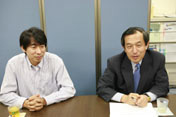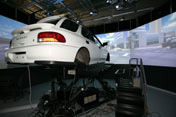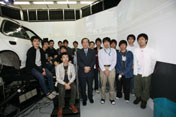Hironao Kawashima, Professor, Faculty of Science and Technology
Tatsuru Daimon, Associate Professor, Faculty of Science and Technology
Public Transportation in evolution---using advanced technology for highly public road traffic
Deep understanding of human nature helps increase public aspects of road traffic



ITS is a general technology that connects people and automobiles
ITS (Intelligent Transport Systems) is a national project to integrate people, roads and cars with a wireless network in order to increase public aspects of road traffic, and to realize a comfortable and safe car-oriented society. ITS services that are presently available include VICS (Vehicle Information and Communication System) that provides traffic information to drivers though car navigation systems, and ETC (Electronic Toll Collection System) on toll roads. Various technologies are used in these services, such as GPS technology, wireless communication technology, and HMI (Human Machine Interface) technology to provide information in an easy-to- understand manner, to name a few. The human engineering research group of Prof. Kawashima and Assoc. Prof. Daimon also utilizes cognitive engineering and applied psychology to study basic engineering and evaluation methods in adopting ITS. Their laboratory in the B2 floor of the House of Creation and Imagination in Yagami Campus holds a 360-degree driving simulator, rare equipment worldwide which was co-developed with the National Institute for Land and Infrastructure Management. Many experiments are performed to collect and analyze behavior and biological reaction of drivers to further study how to provide literal, visual and phonetic information through on-board equipment of car navigation systems, development of on-road equipment, and also general planning of next-generation traffic information systems.
To meet the needs of all drivers
As a result of the aging society, our country is expected to face serious problems with increasing elderly drivers with poor reflexes and slow comprehension. Assoc. Prof. Daimon says that by using the driving simulator on many elderly drivers, they can collect behavior data of these drivers which will help develop a car navigation system that is easy to understand for the elderly. They also collect evaluation data from women, people with hearing difficulties and non-Japanese. "Which type of drivers require what kind of information in which timing... we are finally prepared to discuss and study these issues." says Prof. Kawashima.
According to Prof. Kawashima, in the future, a "car-to-car communication" system using a wireless network instead of the present way of flashing lights may become available and a "probe car" may appear on the streets to utilize each car as a moving sensor to collect traffic information or road surface information on a snowy day. These new technologies will be based on the enormous amount of evaluation data of "people" accumulated in the Kawashima and Daimon laboratory.
an example of a research theme...."No more blind spots when making right turns!"
For Tetsuya Fukuda (second-year of graduate school), his research theme is safety assistance in making right turns in urban intersections where many accidents occur. When waiting to make a right turn, a truck may be waiting in the opposite lane to also make a right turn, and behind the truck becomes a blind spot and can cause accidents. Therefore, he has come up with the idea of placing a camera above the intersection to provide visual information of the blind spot to the driver's car navigation system. Fukuda, who says he wanted to study something that will help the society, repeats experiments with the driving simulator, dreaming that one day, awful traffic accidents will become a thing of the past.
Faculty's Profile
Prof. Hironao Kawashima, Faculty of Science and Technology
Prof. Kawashima finished the Graduate School of Science and Technology with a Ph.D. in 1973. He has been professor of the Department of Administration Engineering since 1992. He has served numerous times as chairperson and/or member of related committees of several ministries, and was awarded by the Minister of Economy, Trade and Industry for promoting international standardization of ITS. He has published books such as "What is ITS----information revolution and car-oriented society" (Iwanami Shoten).
Assoc. Prof. Tatsuru Daimon, Faculty of Science and Technology
Assoc. Prof. Daimon finished the Graduate School of Science and Technology with a Ph.D. in 1995. He continued on with his research at the Institute for Human Science and Biomedical Engineering of the National Institute of Advanced Industrial Science and Technology and the French National Institute for Transport and Safety Research before coming back to Keio University as Assistant Professor of the Department of Administration Engineering of the Faculty of Science and Technology. He became Associate Professor in 2003. Since 2005, he also serves the Ministry of Land, Infrastructure and Transport as a member of a pilot program for safety driving assistance service of the Sangubashi area of the No.4 line of the Metropolitan Expressway.
*Position titles, etc., are those at the time of publishing.
